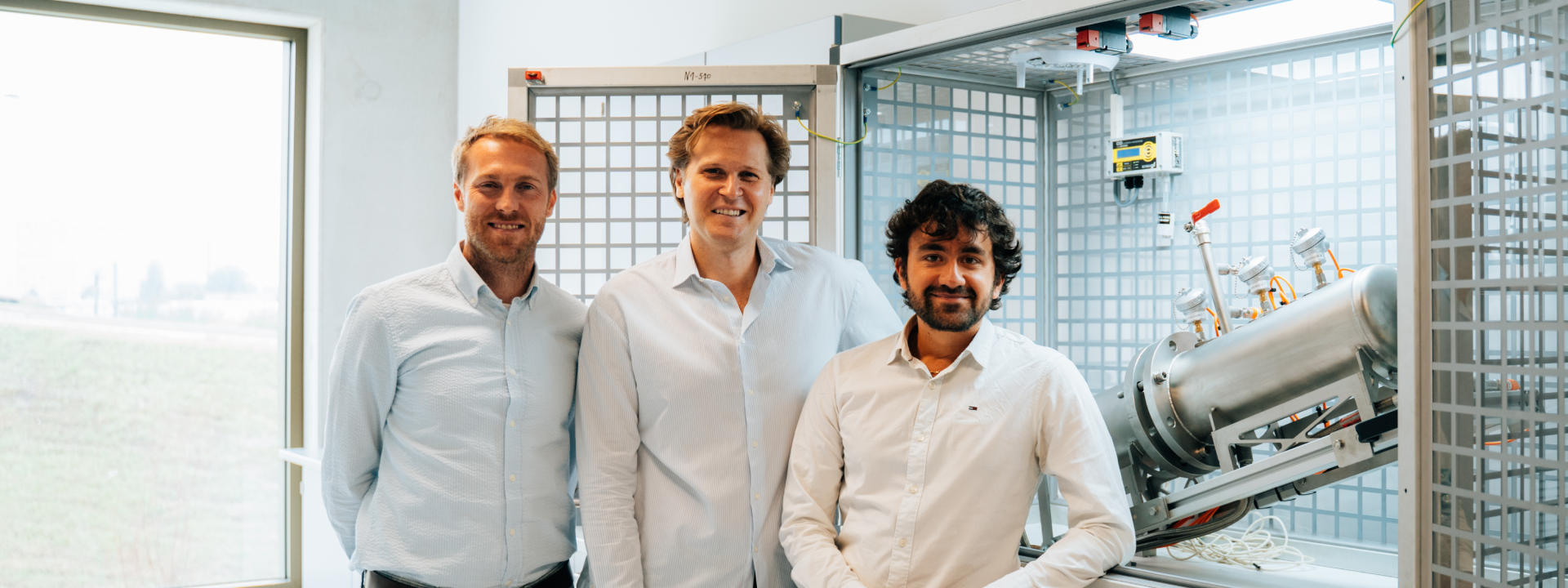
Revolutionizing ClimateTech:
D-CRBN’s road to decarbonization
David Ziegler, Chief Commercial Officer and co-founder of D-CRBN, sits down with us to discuss the company’s innovative CO₂ conversion technology, the challenges of scaling in ClimateTech, and his vision for a sustainable future.
You’re one of three co-founders of D-CRBN. How did you meet, and what inspired you to start the company together?
We are actually a team of six co-founders, with three of us actively involved full-time and three others in an advisory role. Co-founder Gill Scheltjens, with his extensive expertise in scaling plasma technology, was approached by the University of Antwerp to support Georgi Trenchev, a PhD student and plasma wizard, in starting a spinoff. Gill asked me to join D-CRBN because of my business background.
Gill and I have known each other for more than 25 years, sharing not just a professional rapport but also a solid bromance. We had always dreamed of starting a business together and this was our opportunity. If anything, it proves that working with friends can lead to success without conflict!
As Chief Commercial Officer, you oversee the Sales & Marketing strategy. How crucial is marketing to D-CRBN’s success, and what are your main priorities in this area?
Marketing is absolutely vital to D-CRBN's success, especially as a start-up in a highly competitive and rapidly evolving sector like ClimateTech. Visibility is key; it's essential for us to stand out and clearly communicate our unique value proposition. My main priorities have been to build market traction and gain a deep understanding of what our customers expect from us.
Within sales and marketing, my focus has been on creating a strong brand presence and fostering relationships that will drive adoption of our technology. My goal is to promote a sustainable future and position D-CRBN as a leader in industrial decarbonization.
Have you always been passionate about environmental issues, or was there a defining moment that led you down this path?
Before joining D-CRBN, I spent a decade in the diamond industry, where sustainability and traceability were growing priorities. However, the lack of urgency and tangible progress often left me feeling frustrated. I wanted to work on projects that deliver tangible results and have a large-scale impact on addressing the climate change problem—and that’s what lead me to D-CRBN.
ClimateTech is gaining traction, but do you feel it’s receiving the attention and support it truly deserves?
ClimateTech is gaining visibility, which is encouraging, but the level of investment and policy support still falls short of matching the urgency of the climate crisis. Start-ups in this space, like D-CRBN, often face the "valley of death" when scaling hardware solutions—a stage where significant funding and support are crucial to bridge the gap between development and commercialization. To fully unlock ClimateTech's potential, we need stronger financial backing, accelerated market adoption, and deeper collaboration between governments, industries, and investors.What would you say has been your biggest milestone so far, either professionally or personally?
Starting our company has been one of my biggest milestones, as it gave me the chance to work on solving one of the world’s most urgent challenges: climate change. On a personal level, welcoming my first child eight months later brought a completely new perspective to this journey. Balancing the highs and lows of building a business while becoming a parent has been deeply rewarding.
Entrepreneurship comes with its challenges. What’s been the toughest aspect for you, and how do you manage to push through?
For me, personally, the toughest part is hearing a "no" from a potential lead, especially when you know your technology could significantly help them decarbonize their products. It’s frustrating, but I remind myself that we’re playing a long game. Building trust, educating the market, and aligning with the right timing are key.
Fundraising and pitching can be daunting for many entrepreneurs. What has your experience been like in these areas?
In the future, our potential investors are likely to include some of the first people I connected with nearly four years ago. This highlights that strong relationships and trust built over time lead to meaningful investment opportunities. We’ve been fortunate to reduce the likelihood of pitching directly for money; instead, most of our efforts have been focused on increasing visibility and driving commercial traction.
Where do you see the most exciting opportunities for technological advancements in ClimateTech?
I believe the most exciting opportunities lie in a mix of solutions rather than relying on a single approach to solve our climate problem. Advancements in carbon capture, utilization, and storage (CCUS), like our plasma-based technology, are crucial for decarbonizing hard-to-abate sectors such as heavy industry. Tackling climate change requires diverse technologies working together, tailored to the specific needs of industries and regions. Collaboration and innovation across these areas will ultimately drive the systemic changes needed for a sustainable future.
What role do you think SuperNova plays in strengthening the tech ecosystem in Belgium?
SuperNova plays a key role in strengthening Belgium’s tech ecosystem by connecting innovators, investors, and industry leaders. It highlights local talent and puts Antwerp at the center of innovation, showcasing the city as a dynamic hub for groundbreaking technologies. As someone born and raised in Antwerp, that makes me incredibly proud. Seeing the city take on such a leading role in the global tech landscape is truly inspiring.